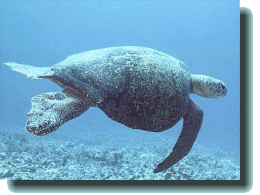
| She's very different from honu 51K JPEG |
We first sighted this strange-duck-turtle on our July 11th morning dive. She's very different from honu.

| She's very different from honu 51K JPEG |
As she swam away, we both concluded she was a black turtle taking a Hawaiian vacation.
We've waited until this week to report on her because we needed time to confirm what she is. We notified George Balazs (National Marine Fisheries Service, Honolulu, Hawaii) and shared photos of this turtle via email.
George replied:
"Can you try hard to get a plastron shot? That will help seal the lid (short of snip for DNA)."
So we did. Her plastron is gray, we told him, and has pale-yellow running longitudinally through it.
As a result George concluded that this turtle is either a black or possibly black/Hawaiian "mix." George is coming over next week to see the beast for himself. We're sure that his expert eyes will tell us more.
For now, we can say Ho'omalu's a very different duck. When she rests next to a cluster of honu, her presence is as jarring as a button mushroom in a crate of eggs.
When she rests next to a cluster of honu, her presence is as jarring as a button mushroom in a crate of eggs 59K JPEG | 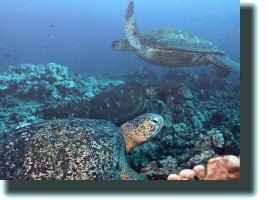
|
We've given her the Hawaiian name Ho'omalu, meaning "to bring under the care and protection of." We hope this name will keep her safe she's while visiting with us. We don't believe she'll stay around here. (We're pretty sure she calls some place else home.)
There are problems, however.
She's already showing early fibropapilloma (FP) symptoms... or at least that is what we interpret them to be. Will she stay here? Hope not--because Ho'omalu has blundered onto one of the highest FP sites in Hawaii.
Will she leave? We worry about that too. We fear that she might take FP with her.
Also, because of us, she's learned humans are safe--which is fine if she stays in Hawaii, where sea turtles are afforded respect and protection. Should her journey take her elsewhere in the Pacific, the "lesson" we taught her--that humans are safe--is even more deadly than any tumor disease.
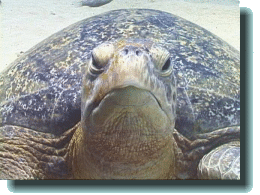
| Should her journey take her elsewhere in the Pacific, the "lesson" we taught her--that humans are safe--is even more deadly than any tumor disease 51K JPEG |
This is our third Cladophora bloom in as many years. The 2000 Cladophora bloom is now worse than the "original" one in 1989. Will it become as bad as 1991? The algae slime still has half a summer to make its mark.
We are diving in slime 30K JPEG | 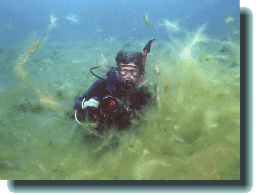
|
Calm water and sunny days have spurred algae growth in the shallows as well. This makes snorkeling most unpleasant. We are diving in slime--and worse, the sea turtles here are living in slime. ...and speaking of slime...
The sea hares Stylocheilus striatus are leaving their own slime trails. Soon they will provide us with our annual entertainment---"snail rains". Vast numbers of these sea hares will float in the water column and do whatever it is sea hares do.
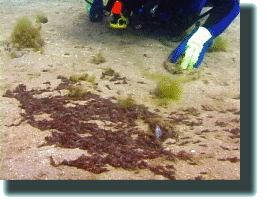
| We've already witnessed their first token swarming 61K JPEG |
They are already forming their "rivers" and we've already witnessed their first token swarming. We've often wondered where they all come from, and this week we found out. They hide in the Cladophora. Dozens and dozens in each slime-plant.
They hide in the Cladophora, dozens and dozens in each slime-plant 48K JPEG | 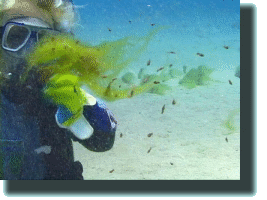
|
Then, for some reason, on some signal they all leave the relative safety of bottom cover and float with their kind in the water. Millions and millions of them.
It's clear that they're in the turtle forage--so many the honu can't help but swallow these sea hares. Do the sea hares, by feeding here at Honokowai, carry inside them toxins that might be a factor in FP? No one knows--but we can't help but ask the question.
Raphael was back this week. An old friend since 1992, we hadn't seen her since Summer 1998. We know she was at Honokowai in January 1999 because George Balazs sighted her on one of his visits here, but we didn't see Raphael last summer. We figured she might be mature enough now to be making her first migration run to the French Frigate Shoals.
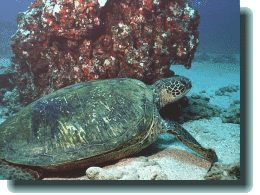
| We sighted her resting peacefully by Mt. Balazs at North House 68K JPEG |
We sighted her resting peacefully by Mt. Balazs at North House. She let us get as close as we wanted. Try as we might, though, we just couldn't find any engraving on her carapace that would confirm she'd nested at East Island.
No matter. Raphael, an FP regression case, remains robust and healthy. Who could ask more from a friend?
This week we resighted Kamaha'o. We've known this turtle since 1993, when she was just a little honu.
Kamaha'o is Hawaiian for "remarkable." In our experience at Honokowai, this is the only juvenile turtle that has ever fought its way back from fibropapilloma and survive. In 1994, Kamaha'o had eye and mouth tumors, and was notably emaciated.
This turtle looked to be doomed.
In 1997, we resighted Kamaha'o and her tumors were gone! We rejoiced. We don't know why or how the turtle recovered--we are simply grateful. We've seen Kamaha'o every summer since and this week, an impressive looking turtle lay resting beside Mt. Balazs at NorthHouse.
It was Kamaha'o, healthy and prospering.
It was Kamaha'o, healthy and prospering 53K JPEG | 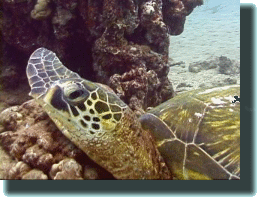
|
 Who's Who Underwater at Honokowai
Who's Who Underwater at Honokowai